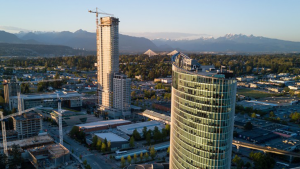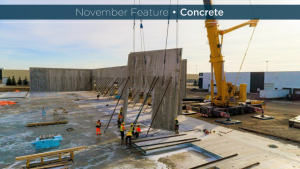The safety of six-storey wood frame construction is being questioned after a housing project, being built under new regulations, was destroyed by a fire in Richmond, B.C.
The safety of six-storey wood frame construction is being questioned after a housing project, being built under new regulations, was destroyed by a fire in Richmond, B.C.
Associations representing cement manufacturers and masonry contractors, as well as the COO of a steel fabricating and installing company have raised concerns.
“Thank God we are having this conversation now and no one died,” said Carolyn Campbell, executive director of the BC Ready-Mixed Concrete Association.
“In pursuit of being the greenest premier in B.C. ever, Gordon Campbell fast-tracked changes to the B.C. building code. The concerns raised by fire services were shoved to the side.”
The Office of Housing and Construction adopted changes to the B.C. Building Code in April 2009, which increased the limit on wood-frame structures from four to six storeys.
A massive fire ripped through a condominium project under construction in Richmond, B.C. earlier this month.
The fire was so intense that firefighters were unable to put it out before 251 unfinished condo units collapsed into a pile of smoldering rubble.
“Our main concern from a masonry standpoint is that sprinkler systems usually perform well when constructed, but they are not there when construction is taking place,” said Bill McEwen, executive director of the Masonry Institute of B.C.
“However, concrete block walls are there when the framing goes up.
“It is effective against fires because it is there when a building is being constructed.”
With the changes to the building code, the usual concrete block firewalls weren‘t used and the buildings didn’t have the protection of fire resistant walls during construction.
The Architectural Institute of British Columbia (AIBC) and the Association of Professional Engineers and Geoscientists of B.C. provided a joint submission to the government in support of the building code changes, but they did express some concerns.
One concern identified by the AIBC was the effect of shrinkage in relation to all building systems, which has implications for other parts of the code.
In particular, there was concern about fire resistance, water supply, fire flow capacity requirements for sprinklers and the risks to firefighters and emergency responders.
“A change to wood/drywall walls was apparently made due to concerns about the large amount of shrinkage expected in six storeys of wood framing, compared to the stable height of concrete masonry,” said McEwen.
“If so, then I feel that this issue should be addressed directly, without losing the safety and protection benefits of block firewalls.”
McEwan and Campbell said that the combination of masonry firewalls, sprinklers and smoke alarms provide the best combination for fire safety in wood frame structures.
“We stood against the changes at the time,” said Campbell.
“We would really like to see passive containment systems, including cast in place, pre-cast, insulating concrete forms and masonry, remain part of the building code.”
Masonry firewalls work passively and provide protection from the day they are installed during construction, while sprinklers are an active system.
The revised building code added new seismic safety provisions to account for the possibility of earthquakes.
“Depending on sprinklers exposes these buildings to possible failure of alarm and mechanical systems, and to a water supply that could be cut-off in an earthquake,” said McEwan.
“In contrast, masonry firewalls provide protection from the day they are installed during construction, and work passively just by being there over the life of the residence.”
The Remy is a showcase project for innovative wood frame design and it is part of an overall provincial government initiative to promote the use of wood.
However, some people in the industry argue that the policy of promoting wood as the primary building material is ill conceived.
“When government chooses to drive the agenda of a particular industry and downplay legitimate safety concerns, the result can be anticipated,” said Norm Streu, chief operating officer with LMS Reinforcing Steel Group. “The increased risk of fire with the Wood First building code changes is not a surprise. It has been well known to fire departments, design professionals and building approval officials for years.”
According to Streu, the decision to use a particular material or building system should be determined by the intended function of the structure.
“Government should get out of the Wood First business entirely and leave the selection of building materials to the design and development community,” he said.
“These professionals will choose the materials that meet safety and other requirements of their clients. Everyone’s focus should be on building quality, durable, economical and safe buildings, not on supporting a particular industry.”
Other’s believe that the policy is also flawed because it undermines the economic interests of workers, who earn a living outside of forestry.
“People in the concrete-based industries are manufacturing less and losing jobs, which are being given to the wood industry,” said McEwan.
“Bricklayers are losing work to carpenters, which shifts or trades jobs with no net gain.”
Given these concerns, Campbell argued that the provincial government should put a moratorium on further changes to the B.C. Building Code that promote the use of wood.
Do you have concerns about the safety of six-storey wood frame structures? Let us hear about it at editor@journalofcommerce.com.











Recent Comments
comments for this post are closed